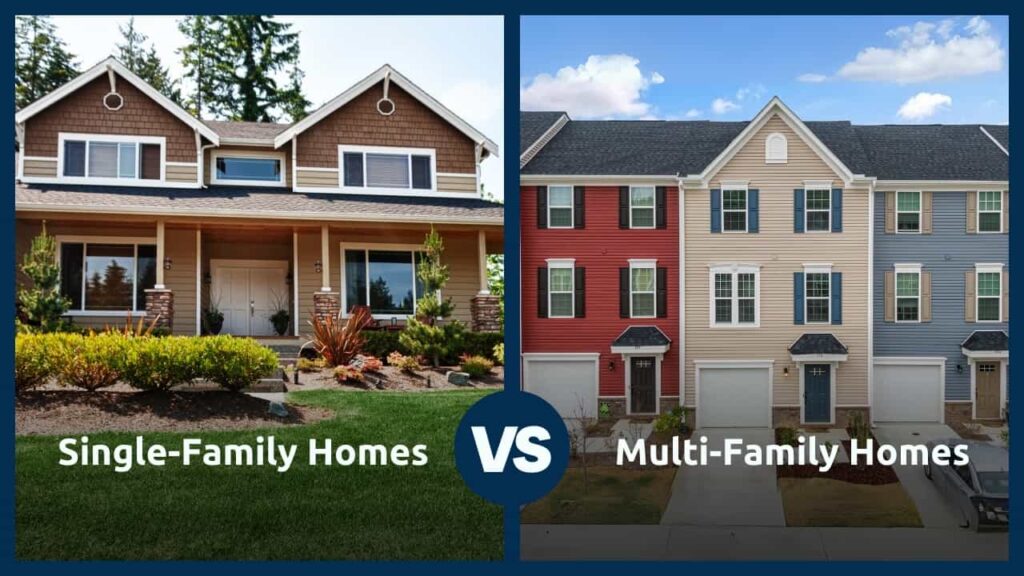ApexStone Capital | Strategic Multifamily Investments for Long-Term Growth
Single-Family vs. Multifamily

When you think about real estate, the first image that probably comes to mind is the classic single-family home. It's the American Dream, right? However, after years of managing single-family investments, I’ve recently found myself diving deep into the multifamily space, and let me tell you—it’s a game-changer.
In this blog, I’m going to share my journey from managing single-family homes to making the leap into multifamily properties. Along the way, I’ll break down the pros and cons of both types of investments to help you decide where you want to focus your energy and capital. Let’s dive in!
The Single-Family Home Experience: Why It Was Time to Move On
Before we talk about the shine of multifamily, let’s go over the reality of single-family investing—because not all that glitters is gold.
Eviction Headaches
One of my tenants has been, let’s just say, a challenge. Despite my best efforts to collaborate with them, we’re now headed toward an expensive eviction. This process is emotionally and financially draining, and it’s one that I’m sure many investors have faced at one point or another.
The Section 8 Dilemma
As some of you might know, Section 8 provides rental vouchers for low-income families. Sounds great in theory, but when the housing authority doesn’t have the budget to increase voucher amounts, and insurance costs rise by 20%, you’re stuck with stagnant rents. This means you can’t raise rents to cover rising costs, leaving you with little flexibility to manage the property.
The Multifamily Glow-Up: My Journey to Multifamily Investing
While single-family investing provided great lessons, multifamily real estate has completely changed my approach to building wealth. I’ve recently partnered as a general partner to manage a 26-unit townhome community in Portland, and let me tell you—it’s been a total upgrade.
Why Multifamily Works for Me (and Could Work for You)
- Professional Property Management
No more waking up to tenant calls at 10 PM. By having a professional property management team in place, I can focus on growing the portfolio instead of putting out fires. - Financial Cushion (Reserves)
Having ample financial reserves in place means we aren’t scrambling when unexpected expenses arise. It’s like a safety net for investors, ensuring steady performance even during rough patches. - Scalability & Efficiency
With 26 units under one roof, we’re able to scale operations efficiently. The larger property size means less overhead and maximized operational efficiency—which is exactly what you want when you’re managing a portfolio. - Construction & Value-Add Potential
We’re able to execute value-add projects, such as upgrading apartments and improving amenities, which increase both rent potential and property value. It’s not just about maintaining the property; it’s about actively growing it.
Single-Family vs. Multifamily: A Battle of Pros and Cons
So, what’s the deal with these two types of investments? Are they really that different? Here’s a breakdown:
Single-Family Homes
Pros:
- Affordable Entry Point: Lower initial capital required makes single-family homes more accessible.
- Attractive to Buyers: Families and investors love these properties for their charm and potential for future resale.
Cons:
- Vacancy Roulette: One tenant moving out means you’re at $0 income until you fill the vacancy.
- Multiple Properties, Multiple Headaches: Managing several single-family homes can become overwhelming—especially when they’re spread across different locations.
- One Bad Tenant: One problematic tenant can wipe out your cash flow.
Multifamily Properties
Pros:
- Income Stability: Even if one unit is vacant, the other tenants still generate income. This reduces the risk significantly.
- Professional Management: You hire a team to handle the day-to-day, leaving you with more time for other things.
- Forced Appreciation: By executing value-add projects, you can increase the property’s value and maximize returns.
- Built-In Community: When tenants are happy, they stay longer, reducing turnover and stabilizing cash flow.
Cons:
- Higher Initial Investment: Larger properties require a more significant upfront investment.
- Intense Competition: Multifamily markets are competitive, so finding the right deal can be a challenge.
- More Complex Operations: The financing and management of multifamily properties can be more complex than single-family homes.
Looking Ahead: Why Multifamily Is the Future
While single-family homes will always have a place in the market, multifamily properties align more with where I want to take my investment strategy. The scalability, income stability, and long-term potential of multifamily investments make them a more suitable option for building wealth in today’s market.
What’s the takeaway here? If you’re looking for consistent cash flow, the ability to scale efficiently, and the chance to increase the value of your properties, then multifamily is where the future lies.
Disclaimer:
This blog post is for informational purposes only and should not be considered as financial advice. Always consult with a financial advisor before making investment decisions.
Share this post:
- Client : Enetrac int.
- Date : January 14, 2022.
- Link : info@archo.com
- Trade : Architecture.
Project Description
- Annual award for architecture work.
- Professional design approved by stakeholders.
- Fast software and modeling for reality interior design.
- True activated software and modeling for reality.
- Drawing software and modeling for reality engineering.
- True activated software and modeling for reality.
- Client : Enetrac int.
- Date : January 14, 2022.
- Link : info@archo.com
- Trade : Architecture.






